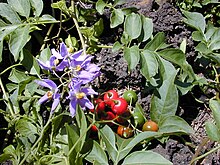
Back Solanum Afrikaans مغد Arabic مغد ARZ Quşüzümü Azerbaijani قوشوزومو AZB Эт ҡарағаты ырыуы Bashkir Паслён Byelorussian Кучешко грозде Bulgarian Solanum Catalan Solanum CEB
| Solanum | |
|---|---|

| |
| Brazilian nightshade (Solanum seaforthianum) | |
| Scientific classification | |
| Kingdom: | Plantae |
| Clade: | Tracheophytes |
| Clade: | Angiosperms |
| Clade: | Eudicots |
| Clade: | Asterids |
| Order: | Solanales |
| Family: | Solanaceae |
| Subfamily: | Solanoideae |
| Tribe: | Solaneae |
| Genus: | Solanum L.[1] |
| Type species | |
| Solanum nigrum L.[2] | |
| Subgenera | |
|
Bassovia | |
| Synonyms | |
|
Androcera Nutt. | |

Solanum is a large and diverse genus of flowering plants, which include three food crops of high economic importance: the potato, the tomato and the eggplant (aubergine, brinjal). It is the largest genus in the nightshade family Solanaceae, comprising around 1,500 species. It also contains the so-called horse nettles (unrelated to the genus of true nettles, Urtica), as well as numerous plants cultivated for their ornamental flowers and fruit.
Solanum species show a wide range of growth habits, such as annuals and perennials, vines, subshrubs, shrubs, and small trees. Many formerly independent genera like Lycopersicon (the tomatoes) and Cyphomandra are now included in Solanum as subgenera or sections. Thus, the genus today contains roughly 1,500–2,000 species.
- ^ "Solanum L." Germplasm Resources Information Network. United States Department of Agriculture. 2009-09-01. Retrieved 2013-07-15.
- ^ Solanum | International Plant Names Index. (n.d.). Retrieved August 11, 2023, from https://www.ipni.org/n/30000630-2
© MMXXIII Rich X Search. We shall prevail. All rights reserved. Rich X Search